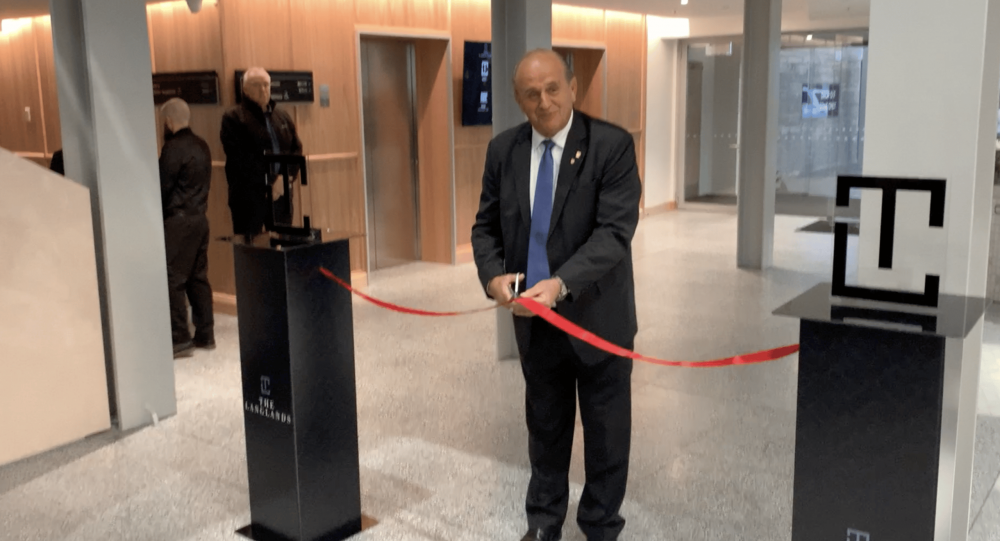
The Langlands Hotel was officially opened today, and ILT board president Alan Dennis formally cut the ribbon for the $52 million, 4.5 star hotel.
The largest single development in ILT’s history, the hotel has 78 rooms and is seven storeys high – a real landmark feature in the city.
Alan reflected in his speech on where Invercargill has come from, and said he was honoured to be opening New Zealand’s newest hotel.
“From the beginning, the board wanted to create a unique experience for both locals and visitors in a modern and contemporary setting. We wanted to add some vibrancy to the inner city and based on the feedback so far I think we’ve done that,’’ he said.
The landmark hotel has always been proposed as more than a hotel with five bespoke eateries and bars included within the development. A soft launch in August saw the accommodation, Brew’d café and the lobby bar Two Doors Down open for business.
This was quickly followed by Niche the laneway bar and most recently the 360, the top floor cocktail bar, which formally opened its door to the public on Friday 23rd September.
ILT’s chief executive Chris Ramsay describes the official opening as a major milestone moment.
“It’s great to be able to share this occasion with those people who have worked tirelessly on this project. It represents the culmination of almost six years of planning and development,” he said.
“We are delighted with the finished product, it is a world class hotel right here in Invercargill and one that we hope the whole community can be proud of.”
Meld, the hotel’s fusion restaurant is the only space remaining to be formally opened. This will be opened as soon as ILT secures the full roster of chefs needed to cater for the hotel’s full menu offering.
“As with all our areas of the business, we want to ensure the experience in Meld is exceptional from day one, hence not wanting to compromise in our recruitment for key positions. The team is eagerly anticipating sharing some of our famous southern manaakitanga,” he said.
Back in 1856, there was only one hotel in the city, owned by William Lind from Denmark.
It consisted of a living room, flanked by two small bedrooms and an open loft for sleeping. It was situated in Dee Street, between Esk and Tay Streets.
In 1864 during the early Gold Rush days, there were 31 hotels serving only 5000 people. “That was at its peak, because one year later, there were nine less, leaving only 22,” Alan said.
Around 1885, there were hotels with familiar names – the Sylvan Bank Hotel, Clinton Arms, Three Horse Shoes and The Governor Gray Hotel.
In the early 1900s just prior to prohibition, some of the hotel names were The Albion, Carriers Arms, the Empire, The Hibernian, The Imperial and The Shamrock.
One hotel/building that remains from this era is the Grand Hotel, across the street, built in 1912.
In 1944 at the end of prohibition the ILT was formed, and the trust quickly established the Clyde, the earlier version of the Kelvin Hotel, Appleby and the Brown Owl.
In 1966, the Kelvin Hotel was completed (NZ’s first new hotel for some years). At the time it was ILT’s first major build. It was designed by local architect Allan Mollison and included a number of rooms, function spaces, bars and restaurants.
Fourteen years later, the Ascot Park Hotel was opened by Prime Minister Robert Muldoon.
“This was a progressive concept at the time, developed with the park lands conference model in mind, it quickly become a flagship conference and events centre. Some wrongly named it ‘Ollys Folly,’ after the chair of the time Ollie Henderson. How wrong he proved his detractors.”
Alan said the Ascot Park Hotel has stood the test of time and continues to be the premium conference venue for Invercargill and ILT.
The total build cost for both the Kelvin and Ascot Park properties was just under $4 million.
Related:
- ILT Confirm $40 Million Hotel For Inner City (2017)
- ILT Appoints Project Manager For City Hotel Development (2018)
- ILT Awards Contract for The Langlands Hotel (2019)
- New ILT Hotel to be The Langlands (2019)
- City Crane Now Has Name (2020)
- Collaboration Adds Artistic Vibe To Construction Site (2020)
- City Block & Hotel Developments Starting To Take Shape (2021)
- Southland Artist Excited To Be Working With ILT on Langlands Hotel (2022)
- New Distinction City Hotel Plans Well Underway, With Late 2023 Opening


